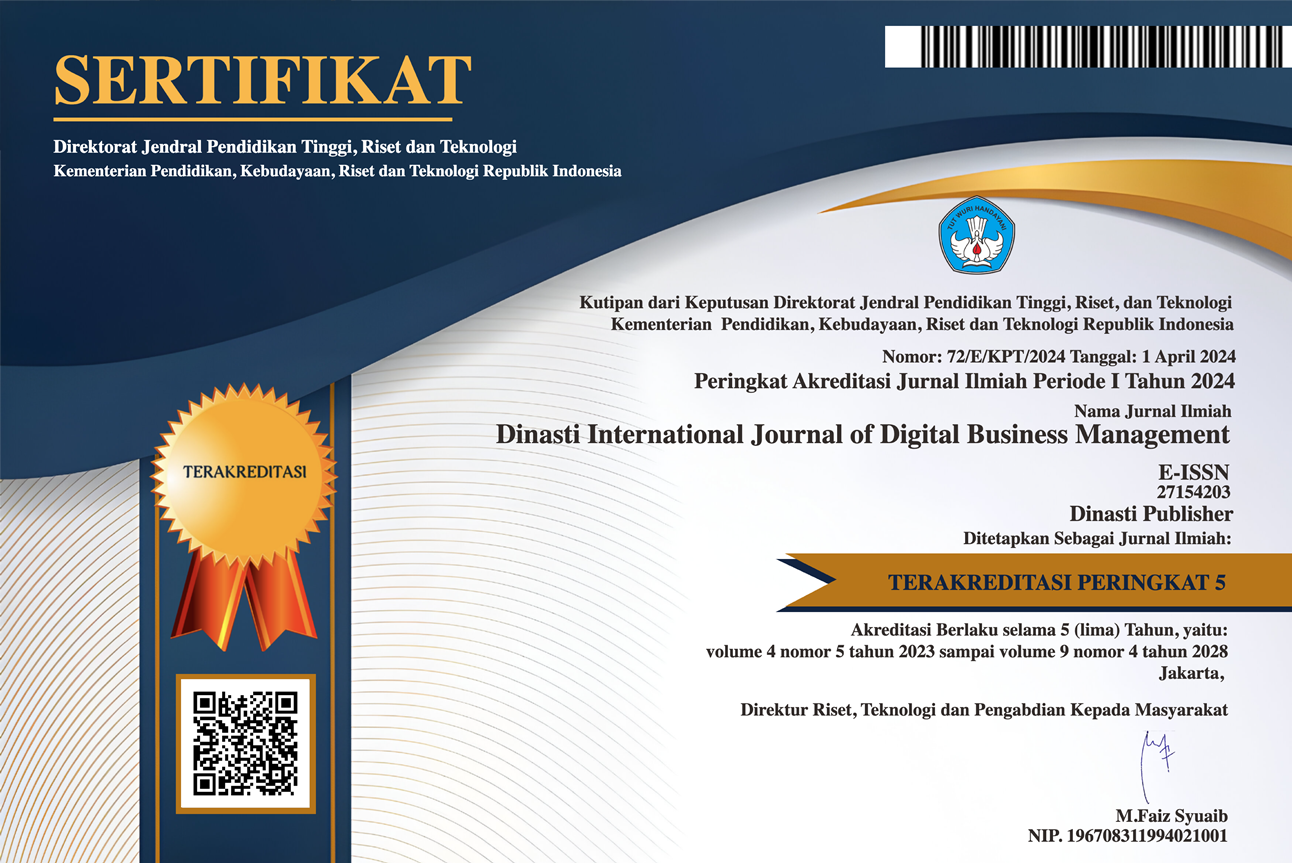The Impact of Digital Marketing and Brand Articulation Capabilities on Marketing Performance of Small and Medium Enterprises: Case Study in West Lombok Province
DOI:
https://doi.org/10.31933/dijdbm.v5i2.2298Keywords:
digital marketing, brand articulation, marketing performanceAbstract
This research investigates the influence of Digital Marketing and Brand Articulation Capabilities on SME Marketing Performance in West Lombok Province, Indonesia. The research results show that Digital Marketing has a positive and significant impact on the Marketing Performance of SMEs, and Brand Articulation Ability also plays an important role in improving their performance. In addition, this research reveals that Brand Articulation Ability acts as a mediating variable in the relationship between Digital Marketing and Marketing Performance. These findings have important implications for SME owners and marketing practitioners, highlighting the importance of investing in effective Digital Marketing and developing Brand Articulation Capabilities. The integration of a good Digital Marketing strategy and the ability to convey a clear brand message can help SMEs achieve success in an increasingly digital and competitive business era.
References
Apasrawirote, D., Yawised, K., & Muneesawang, P. (2022). Digital marketing capability: the mystery of business capabilities. In Marketing Intelligence and Planning (Vol. 40, Issue 4). https://doi.org/10.1108/MIP-11-2021-0399
Chang, S.-H., Chen, C.-H., & Ho, Y. C. (2012). A Study of Marketing Performance Evaluation System for Notebook Distributors. International Journal of Business and Management, 7(13). https://doi.org/10.5539/ijbm.v7n13p85
Costa, A. M., Monteiro, B., & Silva, S. (2021). Wine tourism and digital marketing strategies in the vinho verde region. Proceedings of the International Conference on Tourism Research. https://doi.org/10.34190/IRT.21.034
Diez-Martin, F., Blanco-Gonzalez, A., & Prado-Roman, C. (2019). Research challenges in digital marketing: Sustainability. Sustainability (Switzerland), 11(10). https://doi.org/10.3390/su11102839
Duke, C., Hamidi, S., & Ewing, R. (2020). Validity and reliability. In Basic Quantitative Research Methods for Urban Planners. https://doi.org/10.4324/9780429325021-6
Dunakhe, K., & Panse, C. (2022). Impact of digital marketing – a bibliometric review. In International Journal of Innovation Science (Vol. 14, Issues 3–4). https://doi.org/10.1108/IJIS-11-2020-0263
Emerson, R. W. (2017). Likert Scales. Journal of Visual Impairment & Blindness, 111(5). https://doi.org/10.1177/0145482x1711100511
Gaitniece, E. (2018). DIGITAL MARKETING PERFORMANCE EVALUATION METHODS. CBU International Conference Proceedings, 6. https://doi.org/10.12955/cbup.v6.1145
Godinho, S., & Garrido, M. V. (2017). Branding with the in–out effect: The impact of consonantal articulation on brand evaluation. Psychology and Marketing, 34(9). https://doi.org/10.1002/mar.21031
Gupta, S., Justy, T., Kamboj, S., Kumar, A., & Kristoffersen, E. (2021). Big data and firm marketing performance: Findings from knowledge-based view. Technological Forecasting and Social Change, 171. https://doi.org/10.1016/j.techfore.2021.120986
Hanim, L., Soponyono, E., & Maryanto, M. (2022). Pengembangan UMKM Digital di Masa Pandemi Covid-19. Prosiding Seminar Nasional Penelitian Dan Pengabdian Kepada Masyarakat, 2(1). https://doi.org/10.24967/psn.v2i1.1452
Hunt, S. D. (1995). The Resource-Advantage Theory of Competition. Journal of Management Inquiry, 4(4). https://doi.org/10.1177/105649269500400403
Jayani, D. H. (2020). Pemerintah Beri Stimulus, Berapa Jumlah UMKM di Indonesia? Databoks.Katadata.Co.Id.
Joshi, A., Kale, S., Chandel, S., & Pal, D. (2015). Likert Scale: Explored and Explained. British Journal of Applied Science & Technology, 7(4). https://doi.org/10.9734/bjast/2015/14975
Markovitch, D. G., Huang, D., & Ye, P. (2020). Marketing intensity and firm performance: Contrasting the insights based on actual marketing expenditure and its SG&A proxy. Journal of Business Research, 118. https://doi.org/10.1016/j.jbusres.2020.06.032
Masrianto, A., Hartoyo, H., Hubeis, A. V. S., & Hasanah, N. (2022). Digital Marketing Utilization Index for Evaluating and Improving Company Digital Marketing Capability. Journal of Open Innovation: Technology, Market, and Complexity, 8(3). https://doi.org/10.3390/joitmc8030153
Mehmeti-Bajrami, S., Qerimi, F., & Qerimi, A. (2022). The Impact of Digital Marketing vs. Traditional Marketing on Consumer Buying Behavior. HighTech and Innovation Journal, 3(3). https://doi.org/10.28991/HIJ-2022-03-03-08
Nisa, C., & Pramesti, D. A. (2020). How Do Effective Digital Marketing and Brand Ambassador Stimulate Purchase Intention Today? https://doi.org/10.2991/assehr.k.200529.075
Nuryakin, N., & Maryati, T. (2022). Do green innovation and green competitive advantage mediate the effect of green marketing orientation on SMEs’ green marketing performance? Cogent Business and Management, 9(1). https://doi.org/10.1080/23311975.2022.2065948
Pierre, B., Pitt, L., Chakrabarti, R., Berthon, J. P., & Simon, M. (2011). Brand worlds: From articulation to integration. Journal of Advertising Research, 51(SUPPL. 1). https://doi.org/10.2501/JAR-51-1-182-194
Propheto, A., Kartini, D., Sucherly, & Oesman, Y. M. (2020). Marketing performance as implication of brand image mediated by trust. Management Science Letters, 10(4). https://doi.org/10.5267/j.msl.2019.10.023
Skackauskiene, I., & Vilkaite-Vaitone, N. (2020). Evaluation of Green Marketing Performance: A Methodological Perspective. Scientific Conference on Economics and Entrepreneurship Proceedings. https://doi.org/10.7250/scee.2019.010
Skard, S., & Thorbjornsen, H. (2017). Closed-ended and open-ended fit articulation: Communication strategies for incongruent sponsorships. European Journal of Marketing, 51(7–8). https://doi.org/10.1108/EJM-01-2016-0011
Srivastava, G., & Gupta, D. (2022). Barriers to Digital Marketing in Rural India. Lecture Notes in Mechanical Engineering. https://doi.org/10.1007/978-981-16-3330-0_11
Sultoni, M. H., Sudarmiatin, Hermawan, A., & Sopiah. (2022). Digital marketing, digital orientation, marketing capability, and information technology capability on marketing performance of Indonesian SMEs. International Journal of Data and Network Science, 6(4). https://doi.org/10.5267/j.ijdns.2022.5.013
Su, X., & Yin, W. (2023). Application of Internet big data analysis technology based on deep learning in tourism marketing performance evaluation. Soft Computing. https://doi.org/10.1007/s00500-023-08482-5
Topolinski, S., Zürn, M., & Schneider, I. K. (2015). What’s in and what’s out in branding? A novel articulation effect for brand names. Frontiers in Psychology, 6(MAY). https://doi.org/10.3389/fpsyg.2015.00585
Varadarajan, R. (2023). Resource advantage theory, resource based theory, and theory of multimarket competition: Does multimarket rivalry restrain firms from leveraging resource Advantages? Journal of Business Research, 160. https://doi.org/10.1016/j.jbusres.2023.113713
Wang, Y. J., Capon, N., Wang, V. L., & Guo, C. (2018). Building industrial brand equity on resource advantage. Industrial Marketing Management, 72. https://doi.org/10.1016/j.indmarman.2017.11.009
Wang, Z., & Kim, H. G. (2017). Can Social Media Marketing Improve Customer Relationship Capabilities and Firm Performance? Dynamic Capability Perspective. Journal of Interactive Marketing, 39. https://doi.org/10.1016/j.intmar.2017.02.004
www.djkn.kemenkeu.co.id. (2020). UMKM Bangkit, Ekonomi Indonesia Terungkit. In Kementrian Keuangan Republik Indonesia.
Xie, Q. (2022). Market Network Marketing Performance Evaluation in a Smart City Based on Fuzzy Algorithm. Journal of Testing and Evaluation, 51(3). https://doi.org/10.1520/JTE20220076
Zahara, Z., Ikhsan, Santi, I. N., & Farid. (2023). Entrepreneurial marketing and marketing performance through digital marketing capabilities of SMEs in post-pandemic recovery. Cogent Business and Management, 10(2). https://doi.org/10.1080/23311975.2023.2204592
Downloads
Published
Issue
Section
License
Copyright (c) 2024 Dede suleman, Ety Nurhayaty, Lukman Hakim, Helmy Ivan Taruna, Nurzalinar Joesah, Yuliana Saridewi Kusumastuti, Resti Yulistria

This work is licensed under a Creative Commons Attribution 4.0 International License.
Authors who publish their manuscripts in this journal agree to the following conditions:
- The copyright on each article belongs to the author(s).
- The author acknowledges that the Dinasti International Journal of Digital Business Management (DIJDBM) has the right to be the first to publish with a Creative Commons Attribution 4.0 International license (Attribution 4.0 International (CC BY 4.0).
- Authors can submit articles separately, arrange for the non-exclusive distribution of manuscripts that have been published in this journal into other versions (e.g., sent to the author's institutional repository, publication into books, etc.), by acknowledging that the manuscript has been published for the first time in the Dinasti International Journal of Digital Business Management (DIJDBM).















































